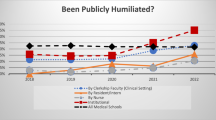Abstract
Background
Few meaningful changes have been made to reduce medical student mistreatment despite years of interventions undertaken based on data regarding mistreatment gathered annually in the Association of American Medical College’s (AAMC) Medical School Graduation Questionnaire (GQ). No studies to date have compared clerkship-specific mistreatment to identify problems unique to individual learning environments. The purpose of this study was to investigate medical student mistreatment during third-year clerkships at a university-based medical school and to evaluate specific mistreatment patterns by clerkship.
Methods
In the 2012–2013 academic year, 122 third-year medical students were surveyed using the AAMC GQ questions on mistreatment behaviors witnessed or experienced during medical school. During each of their clerkships, students were asked to report mistreatment and to specify the individuals responsible for it.
Results
Public humiliation was the most commonly reported form of mistreatment. This was more prominent on Surgery (23.8%), Obstetrics and Gynecology (15.2%), and Internal Medicine (12.4%) versus Neurology (4.8%), Psychiatry (4.3%), Pediatrics (2.1%), and Family Medicine (0%). Faculty (36–64%) and residents (29–50%) were primarily responsible for mistreatment. Students identified many instances of mistreatment in the operating room. More students reported being denied opportunities based solely on gender during Obstetrics and Gynecology than all other clerkships (12 versus 0–2%).
Conclusions
Students reported higher incidences of mistreatment on Surgery, Obstetrics and Gynecology, and Internal Medicine. Operating room culture may contribute to medical student mistreatment. Gender-specific mistreatment occurs during the Obstetrics and Gynecology clerkship, which may affect the educational experience of male students. We recommend a clerkship-specific approach to evaluate mistreatment to successfully identify and address mistreatment across learning environments.

Similar content being viewed by others
References
Fnais N, Soobiah C, Chen MH, Lillie E, Perrier L, Tashkhandi M, et al. Harassment and discrimination in medical training: a systematic review and meta-analysis. Acad Med. 2014;89:817–27.
Silver HK. Medical students and medical school. JAMA. 1982;247:309–10.
Fried JM, Vermillion M, Parker NH, Uijtdehaage S. Eradicating medical student mistreatment: a longitudinal study of one institution’s efforts. Acad Med. 2012;87:1191–8.
Association of American Medical Colleges. Medical school graduation questionnaire: 2012 all schools summary report. Washington, D.C.: AAMC; 2012.
Ahmadipour H, Vafadar R. Why mistreatment of medical students is not reported in clinical settings: perspectives of trainees. Indian J Med Ethics. 2016 Oct-Dec;1(4):215–8.
Peres MF, Babler F, Arakaki JN, Quaresma IY, Barreto AD, Silva AT, et al. Mistreatment in an academic setting and medical students’ perceptions about their course in São Paulo, Brazil: a cross-sectional study. Sao Paulo Med J. 2016;134(2):130–7.
Scott KM, Caldwell PH, Barnes EH, Barrett J. “Teaching by humiliation” and mistreatment of medical students in clinical rotations: a pilot study. Med J Aust. 2015;203(4):185e.1–6.
Siller H, Tauber G, Komlenac N, Hochleitner M. Gender differences and similarities in medical students’ experiences of mistreatment by various groups of perpetrators. BMC Med Educ. 2017;17(1):134.
Bursch B, Fried JM, Wimmers PF, Cook IA, Baillie S, Jackson H, et al. Relationship between medical student perceptions of mistreatment and mistreatment sensitivity. Med Teach. 2013;35:e998–1002.
Haviland MG, Yamagata H, Werner LS, Zhang K, Dial TH, Sonne JL. Student mistreatment in medical school and planning a career in academic medicine. Teach Learn Med. 2011;23:231–7.
Oser TK, Haidet P, Lewis PR, Maugher DT, Gingrich DL, Leong SL. Frequency and negative impact of medical student mistreatment based on specialty choice: a longitudinal study. Acad Med. 2014;89:755–61.
Cook AF, Arora VM, Rasinski KA, Curlin FA, Yoon JD. The prevalence of medical student mistreatment and its association with burnout. Acad Med. 2014;89:749–54.
Mavis B, Sousa A, Lipscomb W, Rappley MD. Learning about medical student mistreatment from responses to the medical school graduation questionnaire. Acad Med. 2014;89:705–11.
Stone JP, Charette JH, McPhalen DF, Temple-Oberle C. Under the knife: medical student perceptions of intimidation and mistreatment. J Surg Educ. 2015;72(4):749–53.
Chapman SJ, Hakeem AR, Marangoni G, Raj Prasad K. How can we enhance undergraduate medical training in the operating room? A survey of student attitudes and opinions. J Surg Educ. 2013;70:326–33.
Ahmer S, Yousafzai AW, Bhutto N, Alam S, Sarangzai AK, Iqbal A. Bullying of medical students in Pakistan: a cross-sectional questionnaire survey. PLoS One. 2008;3(12):e3889.
Gan R, Snell L. When the learning environment is suboptimal: exploring medical students’ perceptions of “mistreatment”. Acad Med. 2014;89(4):608–17.
Ogden PE, Wu EH, Elnicki MD, Battistone MJ, Cleary LM, Fagan MJ, et al. Do attending physicians, nurses, residents, and medical students agree on what constitutes medical student abuse? Acad Med. 2005;80(Suppl):S80–3.
Chang JC, Odrobina MR, McIntyre-Seltman K. The effect of student gender on the obstetrics and gynecology clerkship experience. J Women’s Health. 2010;19:87–92.
Kristoffersson E, Andersson J, Bengs C, Hamberg K. Experiences of the gender climate in clinical training—a focus group study among Swedish medical students. BMC Med Educ. 2016 Oct 26;16(1):283.
Emmons SL, Adams KE, Nichols M, Cain J. The impact of perceived gender bias on obstetrics and gynecology skills acquisition by third-year medical students. Acad Med. 2004;79:326–32.
Dent GA. Anonymous surveys to address mistreatment in medical education. Virtual Mentor. 2014;16:200–3.
Acknowledgements
The University of Michigan Medical School has grant funding for Accelerating Change in Medical Education from the American Medical Association.
Funding
American Medical Association.
Author information
Authors and Affiliations
Corresponding author
Ethics declarations
Conflict of Interest
The authors declare that they have no conflict of interest.
Rights and permissions
About this article
Cite this article
Breed, C., Skinner, B., Purkiss, J. et al. Clerkship-Specific Medical Student Mistreatment. Med.Sci.Educ. 28, 477–482 (2018). https://doi.org/10.1007/s40670-018-0568-8
Published:
Issue Date:
DOI: https://doi.org/10.1007/s40670-018-0568-8




